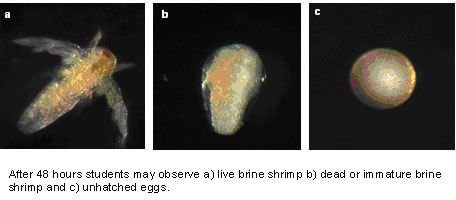The Brine Shrimp, Artemia: Inhabitant of the Great Salt Lake
Description
Brine shrimp are small—the larvae are less than 0.5 mm in length and as adults they are just over 10 mm. They resemble tiny shrimp with their tapered bodies and 11 pairs of appendages. Juveniles have one eye, but a second is apparent by maturity. Females possess a brood pouch that enables the release of live young when conditions are favorable. Males can be identified by modified antennae that help in mating. Artemia’s color varies from blue-green to transparent to red.
Brine Shrimp
Credit: NIAAA / NIH
Habitat and Diet
Brine shrimp are found in the wild in over 250 locations across the globe. Although they are marine lifeforms, brine shrimp do not live in the oceans. Rather, they inhabit inland saltwater lakes or marshes. They tolerate hypersaline environments—that is, water with several times the salt concentration found in the oceans, although they can survive in waters with a less than normal saline content. Brine shrimp prefer to eat Dunaliella—a blue-green algae. Doubtless this is because they are small and easy to digest. When Duniella is scarce, brine shrimp eat the larger and more difficult to digest brown algae and diatoms.

The Great Salt Lake: Utah
Credit: USGS
Reproduction and Growing Larvae at Home
Artemia has a short yet flexible life cycle, which typically lasts one year. The predominant female can live as long as three months. Some species of brine shrimp reproduce through parthogenesis, whereby the female fertilizes her own eggs. Other species reproduce through viviparity, in which the male and the female alike share in fertilizing the eggs. Under optimal conditions, a female shrimp can produce as many as 300 offspring in four days.
Eggs of the brine shrimp can be stored under stringent conditions even for years, and then be successfully hatched. To raise brine shrimp at home, one only needs to provide them water to hatch. Fossweb recommends the following solution and feeding:
4 liters of water
250 ml of rock salt
30 ml of Epsom salts
15 ml of baking soda
Maintained the water level using ordinary tap water (aged a minimum of 24 hours to evaporate chlorine). Feed the shrimp a pinch of bakers’ of brewers’ yeast weekly.
Scientific Classification
Kingdom: Animalia
Phylum: Arthropoda
Class: Brachiopoda
Order: Anostraca
Family: Artimiidae
Genus: Artemia
Species: A. salina
References and Resources
Fossweb: Brine Shrimp
USGS: Utah Water Science Center:Brine Shrimp and Ecology of Great Salt Lake
Portland State University: Artemia (Brine Shrimp) FAQ 1.1
Also from Bright Hub:Experiments to Conduct with Sea Monkey Kits, by Katherine Frantz.
